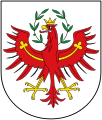Tyrol
Tyrol | |
|---|---|
|
Flag | |
| Motto:Land im Gebirge(Austrian German) Terra inter montes(Ladin) Terra fra i monti(Italian) "Country in the mountains" | |
 Tyrol's southern part is located inNorthern Italyand its northern part inAustria | |
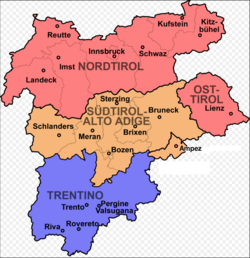 The region consists of present-dayTyrol–South Tyrol–Trentino Euroregion,includingCortina d'Ampezzo,Fodóm(Buchenstein),Col(Verseil),Valvestino,MagasaandPedemonte | |
| Capital | Tirol(1027–1418) Merano(1418–1848) Innsbruck(1848–1918) Innsbruck(1918–today) |
| Official languages | Austrian German,Italian,Ladin,CimbrianandMòcheno |
| Demonym(s) | Tyrolean |
| Area | |
• Total | 26,674 km2(10,299 sq mi) |
| Population | |
• 2017 estimate | 1,813,400 |
• Density | 68/km2(176.1/sq mi) |
| Currency | Euro(€) (EUR) |
Tyrol(/tɪˈroʊl,taɪˈroʊl,ˈtaɪroʊl/tih-ROHL,ty-ROHL,TY-rohl;[1]historicallythe Tyrole;[2][3][4]Austrian German:Tirol[tiˈʁoːl];Italian:Tirolo) is ahistorical regionin theAlpsofNorthern Italyand westernAustria.The area was historically the core of theCounty of Tyrol,part of theHoly Roman Empire,Austrian EmpireandAustria-Hungary,from its formation in the 12th century until 1919. In 1919, followingWorld War Iand thedissolution of Austria-Hungary,it was divided into two modern administrative parts through theTreaty of Saint-Germain-en-Laye:
- State ofTyrol:Formed through the merger ofNorthandEast Tyrol,as part ofAustria
- Region ofTrentino-Alto Adige:At that time still with Souramont (Cortina d'Ampezzo,Livinallongo del Col di LanaandColle Santa Lucia) and the municipalitiesValvestino,Magasa,andPedemonte,seized in 1918 by theKingdom of Italy,and thus since 1946 part of theItalian Republic.
With the founding of the European regionTyrol-South Tyrol-Trentinothe area has its own legal entity since 2011 in the form of aEuropean Grouping for Territorial Cooperation.
Etymology[edit]
According toEgon Kühebacher,the nameTyrolderives from a root word meaningterrain(i.e. area, ground or soil; compareLatin:terraandOld Irish:tir); first from the village ofTirol,and itscastle;from which theCounty of Tyrolgrew.[5]Some sources suggest it derives from the Slavic language "ta rola" meaning "this land, farming terrain/farming ground." According toKarl Finsterwalder,the nameTyrolderives fromTeriolis,a late-Roman fort and travellers' hostel inZirl, Tyrol.[6]There seems to be no scholarly consensus.
Geography[edit]
Location[edit]

Tyrol has an area of 26,673 km2.The region consists of the State ofTyrol,the Province ofSouth Tyroland theProvince of Trento.In addition to the region belong the municipalitiesCortina d'Ampezzo,Livinallongo del Col di Lana,Colle Santa LuciaandPedemontefrom the Region ofVenetoandValvestinoandMagasafrom the Region ofLombardy.The largest cities in Tyrol areInnsbruck,TrentoandBolzano.
The whole region of Tyrol is located in theAlps.Tyrol is bordered to the north by the state ofBavariaand to the east by the states ofCarinthiaandSalzburg.West of Tyrol lies the state ofVorarlbergand the canton ofGrisons.On the southern side of Tyrol, the land is bordered by the regions ofVenetoandLombardy.
Important rivers in Tyrol are theAdige,InnandDrau.The region is characterized by many valleys. Some of these valleys are still difficult to reach today. The most important valleys are theInn ValleyandAdige Valley.A large part of the population lives in these two valleys and also the five largest cities of Tyrol (Innsbruck,Bolzano,Trento,Merano,andRovereto) lie in these valleys. For centuries, the region has been known for transit trade. The most important trade route across the Alps, namely theBrenner Route,traverses the whole of Tyrol and is regarded as a connecting link between the Italian andGerman-speaking areas.
Mountains[edit]

As the Tyrolean region is located in theAlps,the landscape is heavily influenced by the mountains. The highest mountains in Tyrol include:
- theOrtler– 3,905m a.s.l.
- theKönigspitze– 3,851 m a.s.l.
- theGroßglockner– 3,798m AA
- theMonte Cevedale– 3,769 m a.s.l.
- theWildspitze– 3,768 m AA
Across Tyrol, on the border between North and South Tyrol, runs themain chain of the Alps.[7]The main chain of the Alps geographically divides the Alps into a southern and northern half.
Biggest municipalities[edit]




Municipalities of Tyrol with over 10,000 inhabitants:
| Rank | Municipality | Inhabitants |
|---|---|---|
| 1 | Innsbruck | 132,236 |
| 2 | Trento | 117,417 |
| 3 | Bolzano/Bozen | 106,951 |
| 4 | Merano/Meran | 40,047 |
| 5 | Rovereto | 39,482 |
| 6 | Brixen/Bressanone | 21,688 |
| 7 | Pergine Valsugana | 21,363 |
| 8 | Kufstein | 18,973 |
| 9 | Laives | 17,780 |
| 10 | Arco | 17,588 |
| 11 | Riva del Garda | 17,190 |
| 12 | Bruneck/Brunico | 16,356 |
| 13 | Telfs | 15,582 |
| 14 | Eppan/Appiano | 14,900 |
| 15 | Hall in Tirol | 13,801 |
| 16 | Schwaz | 13,606 |
| 17 | Wörgl | 13,537 |
| 18 | Lana | 12,046 |
| 19 | Lienz | 11,945 |
| 20 | Imst | 10,371 |
Austria: 1 January 2017
Italy: 31 December 2016
Society[edit]

Language distribution[edit]
Tyrol can be subdivided into 5 different language groups. In addition to the majority languages such as German and Italian, languages such asLadin,CimbrianandMóchenoare also spoken. The last three languages are recognized as minority languages. These language groups are mostly located in the Trentino-Alto Adige region and are thus promoted and protected by the region. The Ladin language is also spoken outside the region in Souramont (Province of Belluno). Ladin is considered aRhaeto-Romance language. TheCimbrian languageis also used in various linguistic islands (Sette Comuni) outside the region of Trentino-South Tyrol. The Cimbrian and the Mòcheno languages are considered as upper-Bavarian dialects. The majority inTrentinotwo romance languages are spoken:Lombardin western valleys, and isVenetianeastern ones, in central Trentino a transitional dialect between the lombard language and the venetian language is spoken.
Dialects[edit]
In the Austrian state ofTyrol,the German language is used by a large majority. As in many other regions in German-speaking countries, Tyrol also has its own German-language dialect. The Tyrolean dialect comes from theBavarianlanguage. InSouth Tyrol,the Tyrolean dialect was mixed with a few individual Italian words. Due to the difficult accessibility of the valleys in earlier years, many other valleys developed a slightly differentiated dialect compared to the Tyrolean. The Ladin language also has no uniform language, so every valley also has a slight difference inLadinia.
Heraldry[edit]
Although the details of the arms of Tyrol have changed over the centuries, one feature has remained more-or-less constant:argent,aneagle displayedgules,armed (and sometimes crowned)or.[8]Since 1983, the Province ofSouth Tyrolhas its own coat of arms. It is very similar to the coat of arms of the State ofTyrol.The Province wanted to emphasize the historical commonality of the countries.[9]The Province ofTrentoreceived its coat of arms in 1340 and refers to theprince-bishopric of Trento.The formerCounty of Tyrolhad a uniform coat of arms, which was slightly changed over the centuries.
-
Coat of arms ofTyrol (State)
-
Coat of arms of theProvinceofSouth Tyrol
-
Coat of arms of the Province ofTrentino
-
Coat of arms of theRegionofTrentino–South Tyrol
-
Coat of arms of the formerCounty of Tyrolduring theAustro-Hungarian Empire
History[edit]
Prehistory[edit]

The earliest archaeological records of human settlement in Tyrol have been found in theTischofer Cave.They date from thePalaeolithic,about 28,000–27,000BP.The same cave has also yielded evidence of human occupation during theBronze Age(very roughly, 4000–3000 BP (2000–1000 BC)).
In 1991, the mummified remains of a man who had died around 3300–3100 BC were discovered in a glacier in theÖtztal Alps,in Tyrol. Researchers have called himÖtzi(and also other names, including "The Iceman" ). He lived during theChalcolithicor Copper Age, after man had learned how to exploit copper but before man had learned how to make bronze. His body and belongings were very well-preserved, and have been subjected to detailed scientific study. They are preserved in theSouth Tyrol Museum of Archaeology,Bolzano,South Tyrol, Italy.
There is evidence that Tyrol was a center for copper mining in the 4th millennium BC; for example, atBrixlegg.There is also evidence of theUrnfield culture(roughly 1300–750 BC).
Evidence of theLa Tène culture(roughly 450–100 BC, during theIron Age) has also been found; as has evidence of theFritzens-Sanzeno culturefrom about the same period. Toward the end of that time, Tyrol began to be noted in Roman written records. The inhabitants may have beenIllyrians,in the process of being displaced byCelts(perhaps themselves displaced fromNoricumbyProto-Slavs)[citation needed].There are also indications thatAdriatic Venetimay have been present in the south of the region. The Romans called themRhaetians;although it is not clear whether that then meant a specific tribe or confederation of tribes, or was a broader term for the inhabitants of the area. They made wine barrels (an idea which the Romans took from them), and had their own Alpha bet.
Roman times[edit]
In 15 BC, Tyrol was conquered by Roman forces commanded byDrususandTiberius.The Romans establishedRaetiaandNoricumasprovincesof theRoman Empire.Raetia included Vinschgau, Burggrafenamt, Eisacktal, Wipptal, Oberinntal and parts of the Unterinntal. Noricum included Pustertal, Defereggen and parts of the Unterinntal to the right of the Ziller and the Inn.Bolzanoand the extreme south of Tyrol belonged to the province ofVenetia et Histria.
The inhabitants adopted the Latin Language called vulgar Latin or the everyday spoken version vs. the standardized written formal form, and combined it with their own languages. The result wasRomansh,which is still spoken today and is one of the official languages of Switzerland.
The Romans constructedmetaled roadsguarded byfortsthrough Tyrol to connect the Italian peninsula and the lands beyond; notably theVia Claudia Augustaand theVia Raetia.The Romans did not seem to find Tyrol an attractive area in which to build new towns, because there are few of them. One town they did build wasAguntum,near modernLienz.
In late antiquity (from AD 476), Tyrol belonged to theOstrogoths,and it was included in theOstrogothic Kingdom.In 534, the Ostrogoths lost Meran, Vinschgau and Passer to theFranks.The Ostrogothic Kingdom collapsed in 553, after being overrun byBajuvariansfrom the north andLombardsfrom the south. The Lombards established theDuchy of Tridentum(or, Trent; roughly corresponding to modernTrentino) and lower parts of south Tyrol.Slavic peoples,who had recently takenCarinthiafrom the Bajuvarians, settled in east Tyrol.
Middle Ages[edit]
Most of Tyrol came under the control of theDuchy of Bavaria(createdc. 555). The southern parts, including Bolzano,Salorno,and the right bank of theAdige(includingEppanandKaltern) remained under the Lombards. Tyrol was Christianized through the bishoprics ofBrixenandTriento.The frontier remained the same thoughCarolingianandOttoniantimes. The area was subject toStammesrechte(Ancient Germanic laws), such asLex Romana Curiensis,Lex Alamannorum,Lex BaiuvariorumandLeges Langobardorum.[10]

In 1027, EmperorConrad II,in order to secure the important route through theBrenner Pass,allotted the left bank of the Adige (fromLanatoMezzocorona) to the Duchy of Bavaria. During the 12th century, the local nobility went further: they builtTyrol Castlein the moderncomuneofTirolin South Tyrol, near modernMerano;and around 1140, established theCounty of Tyrolas a state within the Holy Roman Empire.
The Counts of Tyrol were at firstVogt(underlords) subject to the Bishoprics of Brixen and Triento; but they had other ideas. They expanded their holdings at those bishoprics' expense. They displaced competing nobles like theHouse of Eppan,and declared their independence from the Duchy of Bavaria; though not without dispute. In 1228, they conceded theSaalforsteto theHouse of Wittelsbach,rulers of Bavaria; as a result, that area remains part of Bavaria to this day.
In 1253, rulership of the County passed by inheritance to theMeinhardiner family.In 1335, the last male heir to the Meinhardiner lands,Henry of Bohemia,died. His daughter,Margaret,thereupon became Countess of Tyrol; but her title was in doubt because of different laws in different lands as to what a woman could or could not inherit. She navigated her way between the competing claims of the Houses of Wittelsbach,LuxembourgandHabsburgby, in 1342, marryingLouis of Wittelsbach.Louis died in 1361. Margaret died in 1369, and bequeathed Tyrol toRudolf of Habsburg.The various dynastic squabbles were resolved that same year by theTreaty of Schärding,under which (for suitable compensation) the Wittelsbachs agreed to relinquish their claims to Tyrol in favour of the Habsburgs.
When the Habsburgs took control of Tyrol, it had roughly its modern size. However, theUnterinntaldownstream fromSchwazstill belonged to Bavaria; theZillertalandBrixentaltoSalzburg;Brixenand thePustertalwere episcopal territories, or part of theCounty of Gorizia.On the other hand, theMontafonand theUnterengadinwere Tyrolean.
Tyrol was of great strategic importance to the Habsburgs. It controlled several important Alpine passes. It connected their landholdings inFurther Austria.In 1406, as the Habsburg lands were split up by inheritance, Tyrol once again became a separate entity (aLandstand), in which the greater landowners had the right to be consulted (Mitspracherecht). During a confusing succession of events, in 1420Frederick IV, Duke of Austriamoved the capital of Tyrol fromMerantoInnsbruck,and Meran lost its earlier importance.
Modern Tyrol[edit]
Tyrol's importance for the Habsburgs was underlined when the Tyrolean capital of Innsbruck became a centre of European politics and culture asHoly Roman EmperorMaximilian Itook up residence there. From the mid-16th century, Tyrol was ruled by younger sons of the Habsburg Emperors, but in 1665, all Habsburg lands were again under the united rule of the EmperorLeopold I.From the time ofMaria Theresa(1740−1780) onward, Tyrol was governed by the central government of the Habsburgs atViennain all matters of major importance. In 1803 the lands of the Bishoprics ofTrentandBrixenweresecularisedand incorporated into the county.
In the 19th century, Tyrol became an early pawn in theNapoleonic WarsduringWar of the Third Coalition.Following defeat byNapoleonatBattle of Austerlitzin 1805, Austria was forced to cede Tyrol to theKingdom of Bavaria,and as a part of Bavaria, it became a member of theConfederation of the Rhinethe following year. TheTyrolean Rebellion,a popular insurrection against Bavarian rule began in 1809, and throughout Tyrol, the Bavarian troops were killed or driven out. The Tyroleans, led byAndreas Hofer,fought mainly as mobile sharpshooters, but despite their success, Austria's defeat in the widerWar of the Fifth Coalitionconfirmed Bavarian rule in Tyrol, but with southern Tyrol (roughly contemporaryTrentinowithBozenand its hinterland) transferred to Napoleon'sKingdom of Italy.
Tyrol was reunified and returned to the Habsburgs following the downfall of Napoleon and decisions at theCongress of Viennain 1814. Integrated into theAustrian Empire,from 1867 onwards, it was aKronland(crown land) ofCisleithania,the western half ofAustria-Hungary.
AfterWorld War I,the victors ruled in 1919 that the southern part of the Austrian crown land of Tyrol was to be ceded to theKingdom of Italy,including the territory of the former Bishopric of Trent, roughly corresponding to the modern-day Trentino, as well as the southern part of the medieval County of Tyrol county, the present-day province ofSouth Tyrol.Italy thus took control of the strategically important Alpine water divide at theBrenner Passand over the south of Tyrol proper with its large German-speaking majority. The remaining northern and eastern parts of Tyrol became thestate of Tyrolin the new rumpAustrian republic.In 1945 followingWorld War II,Austrian attempts and South Tyrolean petitions to reunite South Tyrol with Austria were not successful, but from 1972 onward, the Italian Republic has granted further autonomy to theTrentino-Alto Adige/Südtirolregion.
Politics[edit]
Tyrol–South Tyrol–Trentino Euroregion[edit]

The Tyrol–South Tyrol–Trentino Euroregion was founded in 1998. The aim is to strengthen cooperation between the separated countries.[11]In several areas, such as mobility, agriculture, education and culture will be tried to promote exchange and to raise the awareness of the cultural and historical heritage of the region of Tyrol in the minds of the population. Cross-border projects will be initiated to improve the relationship between the different language groups. To represent common ideas and values in Europe, the Euroregion has a joint office inBrusselssince 1995.[12]The headquarters of the office is inBolzano.Joint decisions are taken by organized three diet (in German:Dreier-Landtag), which have been held since 1991 mostly every two to three years with thestate Dietsof Trento (provincial council of Trentino),Bolzano(provincial council of South Tyrol) and Innsbruck (state council of Tyrol (State)). In 2011, the region was institutionalized and since then has its own legal entity.
Political parties[edit]
Political parties in the Italian part of Tyrol (provinces of Bolzano and Trento) include:
- Partito Democratico(PD)
- Südtiroler Volkspartei(SVP)
- Movimento Cinque Stelle(M5S)
- Lega Nord(LN)
- Greens
- South Tyrolean Freedom
- Die Freiheitlichen
- Trentino Tyrolean Autonomist Party(PATT)
The Austrian part of Tyrol shares the Austrian party system:
- Tiroler Volkspartei;organization of theÖVPin the state ofTyrol,which has dominated local politics since 1945
- Social Democratic Party of Austria(SPÖ)
- Freedom Party of Austria(FPÖ)
- The Greens – The Green Alternative
- NEOS
The multiplicity of parties is due to the fact that Tyrol lies in two different nation states and thus are politically independent of each other. Another reason for the large number of parties is the great independence of the two Provinces ofBolzanoandTrento.By the second statute of autonomy in 1972, the province of Bolzano acquired much of the region's competences and since then has been mostly independent of the province of Trento. The second autonomy statute enabled the linguistic minorities to be better protected.[13]Theregional council of Trentino-South Tyrol,which consists of the two provincial councils of Bolzano and Trento, has less influence and competences. Thus, many parties determine their focus within the provinces. Other parties inTrentino-South Tyrol,especially in South Tyrol, were founded on the example of Austrian parties and have many similarities with theparties in Austria.
Economy[edit]
In the economic sector statistics are shown, which are based largely on numbers and data of theTyrol–South Tyrol–Trentino Euroregion.It lacks individual communities that are outside the Euroregion. As there are no 10,000 inhabitants living in these communities, the statistics hardly distort the territory of Tyrol and the remaining 1.8 million inhabitants.
Tyrol had a total GDP of 67.6 billion euros in 2014. Divided into individual countries, the State ofTyrolgenerated 28.8 billion euros, the Province ofSouth Tyrol20.6 billion euros and the Province ofTrentino18.2 billion euros.[14]In GDP per capita (2015), that means 39,300 euros/capita in the State of Tyrol, 42,400 euros/capita in South Tyrol and 35,500 euros/capita in Trentino. The unemployment rate in the State of Tyrol is 3.2% (2014), in South Tyrol 3.4% (2017)[15]and in Trentino 4.6% (2017).[16]The Tyrol region is one of the wealthiest regions in Europe and, in terms of GDP/capita, is above the EU average, which amounted to 28,900 euros/capita in 2015. The Region ofTrentino-South Tyrolis, in terms of GDP/capita, the wealthiest region in Italy with 37,813 euros/capita in 2015.[17]
Primary sector[edit]

Agriculture and forestry occupy a special position in Tyrol. The many small and medium-sized farms have shaped the landscape and culture in Tyrol for many centuries. In order to be competitive with larger farms outside Tyrol, there is a strongcooperativesystem in Tyrol. South of Tyrol, in the Region ofTrentino-South Tyrol,the cultivation of apples and wine plays an important role. So every tenth apple in Europe comes fromSouth Tyrol.[18]Known wines in Trentino-South Tyrol are theVernatsch,theLagrein,theGewürztraminerand theWeißburgunder.[19]Livestock, grazing and forestry are important at higher elevations and in more northerly areas. Mainly cattle, sheep, goats and pigs are kept.[20]Accordingly, the production of milk andTyrolean Speckin the farms is very important. Horses also play an increasingly important role in livestock, for equestrian sports and farm holidays. TheHaflingerhorses are known in the Tyrolean region and originate fromHafling,nearMerano.[21]
Secondary sector[edit]
The first industrialization reached Tyrol late in the 19th century. Most of these were small businesses that were important only in the local area. A second wave of industrialization took place at the beginning of the 20th century. Particularly affected at that time was the city ofBolzanowith theItalianizationpolicy under Fascism in the 1920s.[22]
In 2011, approximately 10% of the workplaces in all parts of the country were active in the manufacturing sector. Thus lies Tyrol in the EU average at 10.3% (2011).[23]Important branches of industry in Tyrol are the food industry, wood processing and mechanical engineering. The industry in Tyrol consists mostly of small and medium-sized companies. The craft still plays a special role throughout the region. A large part of these craft businesses are still partially small-structured and family businesses. From an economic point of view, the energy sector is important in the secondary sector. Much of the electricity produced is generated byhydropower.
Tertiary sector[edit]
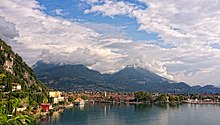
The most important sector in Tyrol is the tertiary sector. Especially tourism has a special position in this region. Due to the connection of the areas by the railway in the 19th century, many villages in Tyrol developed into popular tourism locations. The construction of the Brenner motorway in the 1960s gave the region in the 20th century a renewed upswing in the tourism branch. Today,Merano,Kitzbühel,CortinaorRiva del Gardaare among the most important tourism destinations in the Alpine region. In 2013, theEuroregioncounted over 80 million[24]overnight stays in the Tyrolean region (to compare,Province of Romein 2011: 25.8 million overnight stays).[25]
Also important for Tyrol is the trade. Among other things, theExhibition of Bolzanohas been a meeting point for Italian and German economy already for centuries. As a transit route country, more than 2.25 million trucks (2017) drove over theBrenner Pass.[26]This means that two times more trucks travel on the Brenner Route than in all four Alpine crossing roads in Switzerland together.[27]
Transport[edit]
Tyrol is known as a transit route. The most important route between northern and southern Europe, the Brenner route, traverses the entire region. At 1370 m above the Adriatic, theBrenner Passis the lowest pass crossing of themain chain of the Alps. Due to the linguistic diversity and the climatic transition fromtemperate climate(alpine climate) tomediterranean climate,the area is regarded as a bridge between the Italian and German speaking countries.
Airports[edit]
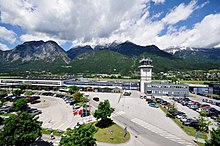
The most important airport in Tyrol isInnsbruck Airport.With over one million passengers, it is the third largest airport in Austria.[28]Other airports in the region are inBolzanoandTrento.These do not offer regular scheduled flights and theBolzano Airportcurrently offers charter flights. There are other small airfields inToblach,Kufstein,St. Johann in Tirol,ReutteandCortina.The airfield in Cortina was closed in 1976 due to a crash.
Road transport[edit]
Highways in Tyrol are the Brenner motorway and the Inntal motorway. The Brenner motorway runs fromInnsbruck(in AustriaA13) to Modena (in ItalyA22). Together with the Inntal motorway fromInnsbrucktoKufsteinis the part of theEuropean route E45.The dual carriageway fromMeranotoBolzano(MeBo) ends in Bolzano South in the Brenner motorway. Important road section inTrentino,next to the Brenner motorway, is the SS 47 (Strada Statale 47), which connects viaSugana ValleyTrentowithPadova.A large part of this route is dual-lane and flows into the Brenner state road (SS 12). Due to theAlps,there are manymountain passesthat connect valleys. The most important pass roads for transit trade are theReschen PassandBrenner Pass.Popular pass roads include theStelvio Pass,Arlberg Pass,Karer Pass,Mendel Passand theGardena Pass.The Provinces ofTrentoandBolzanohave been responsible for the preservation and management of the state roads in their provinces since 1998.[29]
Railways[edit]

The most important railway line in Tyrol is the Brenner Line via theBrenner Pass.TheBrenner Railwaywas opened in 1867 and runs fromInnsbrucktoVeronavia the cities ofBolzanoandTrento.Together with theLower Inn Valley RailwayinNorth Tyrol,this section of the route is part of the important European railway axisBerlin-Palermo,which connects northern Europe with southern Europe across the Alps. With the construction of theBrenner Base Tunneland its completion in 2027, transit traffic on the rail will be promoted and relocated. After completion, theBrenner Base Tunnel,together with theInnsbruck bypass,will be the longest railway tunnel in the world at 64 km and will reduce the travel time betweenBolzanoandInnsbruckfrom 2 hours to 45 minutes.[30][31]
Further important railway lines in Tyrol are theArlberg railway,Zillertal railway,Salzburg-Tyrol railway,Pustertal railway with continuation of the Drautal railway, the railway line Bolzano-Merano and the continuation of the Vinschgau railway, theTrento–Malè–Mezzana railwayand theValsugana railway,which leads fromTrentotoVeniceover theSugana Valley.Cross-border connections are offered only a few. TheÖBBtravels over the Brenner Pass on theEurocitytrains and several regional trains connectSouth TyrolwithNorth TyrolanEast Tyrol.TheEuroregion Tyrol-South Tyrol-Trentinohas set itself the goal of promoting and expanding cross-border connections. The aim is to shift traffic through the Alps to sustainable means of transport, thus protecting the Alpine environment.[32]
Local public transport[edit]
Many villages and communities are difficult to reach because of the large differences in altitude, so the region sets much onropewayconcepts. Although most of thecable carsare located in ski resorts, they are also used for the local public transport. Known cable cars in Tyrol are the Ritten cable car inBolzano,the Sardagna cable car inTrentoand theNordkette cable carinInnsbruck.Alsofunicularrailways are being built to cope with the differences in altitude more quickly. Famous funiculars are among others theHungerburgbahninInnsbruckand theMendel funicularinKaltern.
Local public transport is usually offered with intercity buses or city buses. The city ofInnsbruckhas its own tram network. Anothertramis located inRitten.The cities ofBolzano,MeranoandTrentoformerly had their own tram network, but these were displaced and replaced by the city buses and private transport in the 50s and 60s.
Culture[edit]
The Tyrolean culture has been cultivated for several centuries and passed on to future generations. The state border between South and North Tyrol is more a political border and is considered less as a cultural border. Many traditions are cultivated throughout the Tyrolean region and show little differences. In all cultural areas such as food, dress or customs there are many similarities. Nevertheless, the individual language groups, especially the minority languages, try to maintain and promote their own linguistic identity.
Tyrolean cuisine[edit]
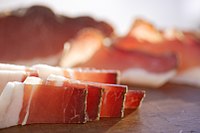
TheTyrolean cuisinehas similarities with theAustrian cuisineand is characterized by its alpine influence. Also the historical influence of the formerK.U.K. Monarchycan be found in the Tyrolean dishes. These include dishes such asgoulash,Kaiserschmarrnandapple strudelwhich are consumed in large parts of theDanube monarchyand today still in Tyrol. Since the region is still relatively strong agricultural and peasant today, also many peasant dishes are offered on the farms.Schlutzkrapfen,boiled dumplingsor cold cuts withbacon (in German:Speck)orgrey cheeseis eaten on the farms.[33]
The Tyrolean dishes show only slight differences throughout Tyrol. Due to the Mediterranean conditions in the southern part of Tyrol, a lot of wine is grown and is therefore also an important part of the Tyrolean dish, especially inSouth TyrolandTrentino.Famous wines from this area are theGewürztraminer,Pinot Blanc,Pinot GrigioandChardonnay.[34]Furthermore, a lot of apples are grown in the Region ofTrentino-South Tyrol.In this region also a food culture is cultivated with a mixture of Italian and Tyrolean specialties.[35][36]
Tyrolean Rifles[edit]

The Tyrolean Rifles were a militia organized in case of an attack oncrown land,which required Tyrol to defend its territory. The militia consisted mostly of citizens and peasants who were responsible only for the defence of their own land and were not obliged to go to war on behalf of theHabsburg monarchy.They were authorized by an order signed byEmperor Maximilian Iin 1511 that remained valid until 1918. The Tyrolean Rifles became known in1809when Tyrolese peasants rose up and fought against the French-Bavarian occupation underNapoleon.The ensuing fourBattles of Bergiselwere led byAndreas Hofer.The Rifles were also used inWorld War Iin 1915 on theDolomite front.After the separation of Tyrol and the downfall of the monarchy, the companies also lost their task of defending their country. Nevertheless, they remained as a non-governmental organization. Today, the Rifles are responsible as an organization for the preservation of the Tyrolean culture and are always present at important political events in Tyrol.[37]
Customs[edit]
Many Tyrolean customs were created centuries ago and are passed on by the population for the next generations. Typical in the Alpine region are the many individual customs in the valleys. Due to the seclusion of the valleys, the locals developed their own customs. Many customs have been created by legends and narratives, others by the close connection to the church. There are also traditions that are cultivated everywhere in the Tyrolean region and do not differ from other valleys and villages. These customs give local people an identity and thus feel the community more connected.[38]
-
Imster SchemenlaufeninImst
-
Herz Jesu Fire in whole Tyrol
Sports[edit]
Tyrol is traditionally a winter sports country. Many athletes, such asGustav Thöni,Benjamin Raich,Carolina Kostner,Gregor Schlierenzauer,Toni SailerandArmin Zöggelerhave already won overall World Cups and medals at World Championships and Olympic Games. Even in summer sports, several athletes from Tyrol were and still are among the best in the world. In water jumpingTania CagnottoandKlaus Dibiasiwon several medals. In cycling,Francesco Moserwon theGiro d'Italia.Andreas Seppiplayed against the best tennis players in the world for many years. InboulderingAnna Stöhrwas one of the best in the world. Many Tyrolean mountaineers such asReinhold MessnerandHans Kammerlanderinfluenced thealpinism.
Football[edit]
TheFC Wacker Innsbruckis one of the most traditional and successful clubs in Austria. Since the club was founded in 1915 and several name changes, the football club has won ten times the Austrian Championship and seven times the Austrian Cup. In 1987, it reached the semi-finals of theUEFA CUP.In 1970, the team defeated Real Madrid in Madrid.[39]Currently (2018) Wacker Innsbruck plays in the "Erste Liga"(second highest category of Austria).
In the Region ofTrentino-South Tyrol,theFC SüdtirolandAC Trentoare the two most important clubs. Both teams have spent the majority of their history between the ItalianSerie C(third highest league in Italy) and the league below,Serie D,although the former reachedSerie Bin 2023 for the first time. AC Trento has a long history as it was founded in 1921,[40]whereas FC Südtirol was founded in 1995.[41]
Ice hockey[edit]
Ice hockey is a very popular sport in Tyrol. Important clubs are theHC Bolzanoand theHC Innsbruck.Both teams play in theEBEL.The HC Innsbruck, formerlyEV Innsbruck,won the Austrian championship seven times. With 19 won Italian championships, the HC Bolzano is the record champion in Italy. The club celebrated the biggest international successes by winning theAlpenliga,theEBELand theSix Nations TournamentwithJaromír Jágr.[42]The Italian ice hockey league consists mostly of South Tyrolean teams. 5 of the 8 Italian teams in theAlps Hockey Leaguecome from South Tyrol (HC Neumarkt-Egna,HC Pustertal,Ritten Sport,HC GardenaandWSV Sterzing Broncos). In this league three more Tyrolean teams play (SG Cortina,HC FassaandEC Kitzbühel).
In 2005, theIce Hockey World Championshipwas held inInnsbruckand Vienna. The1994 Ice Hockey World Championshiptook place inBolzano,Canazeiand Milan.
Volleyball[edit]
In volleyball,Trentino Volleyis one of the best teams in the world. Three times theChampions leaguetitle, four times the clubworld championshiptitle and four times theItalian championshiptitle could win the club fromTrento.Founded in 2000, the club quickly established itself at the top of the league.[43]In 2011,Trentino Volleywon theCEV Champions Leagueahead of its own fans at thePalaOndainBolzano.[44]
Hypo Tirol Innsbruckconquered the Austrian title 10 times. Of the last 13 seasons, the team won 10 times the Austrian championship. Since the season 2017/18 the club plays in the German volleyball league under the name "Hypo Tirol Alpenvolleys Haching". The club went into cooperation with the German teamTSV Unterhaching.[45]
Sports events[edit]

In Tyrol, theOlympic Winter Gameshave been organized three times so far. In1964and1976they were held inInnsbruckand1956inCortina. Most of the big annual sporting events in Tyrol take place in winter. TheAlpine Skiing World Cupis held inKitzbühel,Val Gardena,CortinaandMadonna di Campiglio.These races are classics in the Ski World Cup and have a long tradition. A famousbiathlonlocation is inAntholz.There were often held the Biathlon World Championships. SeveralNordic CombinedWorld Championships were organized inVal di Fiemme.Part of theFour Hills Tournamentis theBergisel Ski Jumpin Innsbruck. A stage of theTour de Skiis also located inToblach.
Some summer sports events are also held in Tyrol. TheTour of the Alpstake place every year in Tyrol. The tour was launched by theEuroregion Tyrol-South Tyrol-Trentino.It is the successor of theGiro del Trentino,which has been around for over 40 years.[46]In 2017, the UCIDownhillWorld Championships took place inVal di Sole,nearTrento.TheBOclassicinBolzanotakes place on New Year's Eve and is one of the best occupied New Year's Eve races in the world.[47]Every year, anATP World Seriestennis tournament is organized inKitzbühel.
Universities and research institutions[edit]
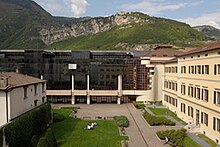


Universities[edit]
- University of Innsbruck
- University of Trento
- Free University of Bozen-Bolzano
- UMIT – Private University for Health Sciences, Medical Informatics and Technology
- Medical University of Innsbruck
Colleges[edit]
- Philosophical-theological Academy Brixen
- Conservatory "Claudio Monteverdi"
- Tyrolean State Conservatory
- University of Applied Sciences Kufstein
- Health university of Applied Science Tyrol
- MCI Management Center Innsbruck
- Pedagogical University of Applied Science Tyrol
- Ecclesiastical Pedagogical University of Applied Science – Edith Stein
- State College of Health Professions "Claudiana"
Independent research institutions[edit]
- Institute for Interdisciplinary Mountain Research, a facility ofAustrian Academy of Sciences
- Eurac Research
- NOI Techpark
- Foundation Bruno Kessler
- Edmund Mach Foundation
- Research-Center Laimburg
See also[edit]
References[edit]
- ^"Tyrol".Random House Webster's Unabridged Dictionary.
- ^The Gentleman's Magazine, Volume 75 (1794),p. 160, atGoogle Books
- ^"Zeitungen aus der ganzen Welt"(in German).Retrieved19 July2017– via PressReader.
- ^Venice under the yoke of France and of Austria,p. PA1, atGoogle Books
- ^Kühebacher, Egon (1991).Die Ortsnamen Südtirols und ihre Geschichte. Die geschichtlich gewachsenen Namen der Gemeinden, Fraktionen und Weiler(in German).Bolzano:Athesia. pp. 470–471.ISBN88-7014-634-0.
- ^Finsterwalder, Karl (1990). "Besprechung zu C. Battisti – G. Giacomelli, I nomi locali del Burgraviato di Merano".Tiroler Ortsnamenkunde. Gesammelte Aufsätze und Arbeiten(in German). Vol. 3. Innsbruck: Wagner. p. 1127.ISBN3-7030-0279-4.
- ^Coolidge, William Augustus Brevoort (1911)..InChisholm, Hugh(ed.).Encyclopædia Britannica.Vol. 26 (11th ed.). Cambridge University Press. p. 1010.
- ^Fox-Davies, A. C.(1909).A Complete Guide to Heraldry.Thomas Nelson and Sons Ltd.pp. 234–235.
- ^"Wappen und Banner: Symbole der Autonomie".Province of South Tyrol.Retrieved11 January2018.
- ^Hannes Obermair (2006)."Das Recht der tirolisch-trientinischen ‚Regio‘ zwischen Spätantike und Frühmittelalter".InConcilium Medii Aevi.9:141–158.DOI:10.2364/1437905809107.
- ^"Willkommen".Euroregion Tyrol-South Tyrol-Trentino. Archived fromthe originalon 22 January 2018.Retrieved20 January2018.
- ^"Europäische Integration und Euregio".Euroregion Tyrol-South Tyrol-Trentino. Archived fromthe originalon 22 January 2018.Retrieved20 January2018.
- ^"Das Autonomiestatut".Province of South Tyrol.Retrieved20 January2018.
- ^"ZAHLEN ZUR EUROPAREGION".Europaregion Tirol-Südtirol-Trentino. Archived fromthe originalon 6 February 2018.Retrieved3 February2018.
- ^"Arbeitlosenquote in Südtirol bei 3,4%".suedtirolnews.it.Retrieved3 February2018.[permanent dead link]
- ^"Istat, Trentino disoccupazione in calo (4,6%)".ansa.it. 7 December 2017.Retrieved3 February2018.
- ^"2015 GDP per capita in 276 EU regions Four regions over double the EU average……and still nineteen regions below half of the average".European Union.Retrieved3 February2018.
- ^"Jeder 10. Apfel europäische Apfel kommt aus Südtirol".IDM Südtirol. Archived fromthe originalon 5 February 2018.Retrieved3 February2018.
- ^"Südtirol Wein".Südtirol Wein.Retrieved3 February2018.
- ^"Zahlen zur Europaregion"(PDF).Europaregion Tirol-Südtirol-Trentino.Retrieved3 February2018.
- ^"Pferde in Tirol:Das Glück der Erde steht auf vier Beinen".Tiroler Tageszeitung. Archived fromthe originalon 1 March 2018.Retrieved3 February2018.
- ^"ECONOMIC HISTORY"(PDF).Handelskammer Bozen.Retrieved4 February2018.
- ^"Zahlen zur Europregion"(PDF).Bundesland Tirol.Retrieved4 February2018.
- ^"Zahlen zur Europregion"(PDF).Bundesland Tirol.Retrieved4 February2018.
- ^"Dati Provinciali sul Turismo: deludono Roma e Firenze, eccellenti Bolzano, Venezia e Rimini".scenarieconimici.it. 22 October 2013.Retrieved4 February2018.
- ^"Transit: Mehr als 2,25 Millionen Lkw fuhren 2017 über den Brenner".stol.it.Retrieved4 February2018.
- ^"Mehr Transit-Lkws über den Brenner als in Schweiz".tirol.orf.at. 2 December 2014.Retrieved4 February2018.
- ^"Flughafen Innsbruck".flugladen.at.Retrieved30 January2018.
- ^"ANAS-Immobilien gehen an das Land über – Vertrag nun unterzeichnet".Provinz Bozen.Retrieved30 January2018.
- ^"Tirol und Südtirol feierten 150 Jahre Brennerbahn mit Railjet".Tiroler Tageszeitung. Archived fromthe originalon 6 September 2017.Retrieved30 January2018.
- ^Scherff, Dyrk."Mit Tempo 250 durch die Alpen".Faz.net.Frankfurter Allgemeine.Retrieved30 January2018.
- ^"MOBILITÄT UND VERKEHR".Europaregion Tirol-Südtirol-Trentino. Archived fromthe originalon 6 February 2018.Retrieved5 February2018.
- ^"Essen und trinken in Tirol".Tirol Marketing.Retrieved21 January2018.
- ^"Südtirol Wein".Südtirol Wein.Retrieved21 January2018.
- ^Pernthaler, Simon."Essen und trinken in Südtirol".suedtirol.info.IDM Südtirol.Retrieved16 July2024.
- ^"Essen und trinken".trentino.Retrieved21 January2018.
- ^"Über uns".Südtiroler Schützenbund.Retrieved21 January2018.
- ^"Brauchtum".Tirol Marketing.Retrieved21 January2018.
- ^"Erfolge".FC Wacker Innsbruck.Retrieved28 January2018.
- ^"storia".AC Trento.Retrieved28 January2018.
- ^"Geschichte".FC Südtirol.Retrieved28 January2018.
- ^"Hall of fame".HC Bozen.Retrieved28 January2018.
- ^"Società".Trentino Volley. Archived fromthe originalon 5 February 2018.Retrieved28 January2018.
- ^"Anche il Kazan si arrende, Trentino BetClic Campione d'Europa per la terza volta consecutiva!".Trentino Volley. Archived fromthe originalon 23 November 2011.Retrieved28 January2018.
- ^"Evers:" Die Wildcard ist eine echte Alternative "".Volleyball Bundesliga.Retrieved28 January2018.
- ^"TOTA – TOUR OF THE ALPS DER EUREGIO".Europaregion Tirol-Südtirol-Trentino. Archived fromthe originalon 6 February 2018.Retrieved28 January2018.
- ^"Silvesterlauf BOclassic".südtirol.Retrieved28 January2018.
External links[edit]
- Official website
 (in German, English, and Italian)
(in German, English, and Italian)


